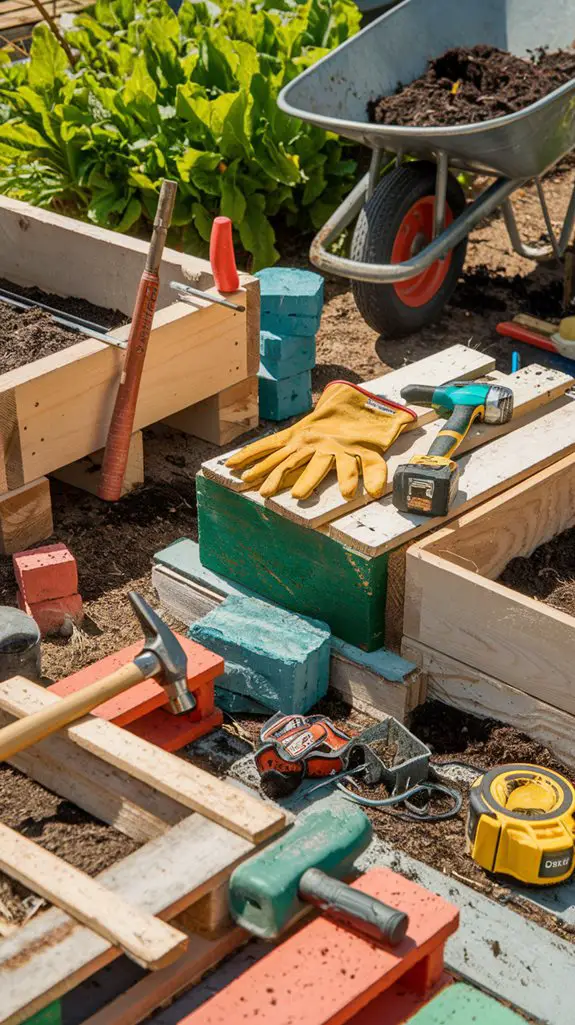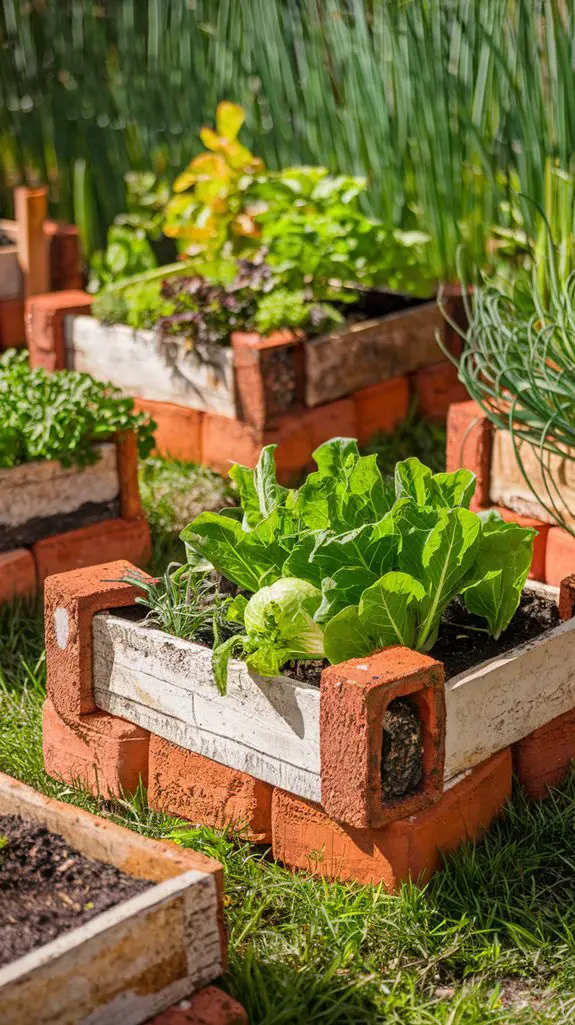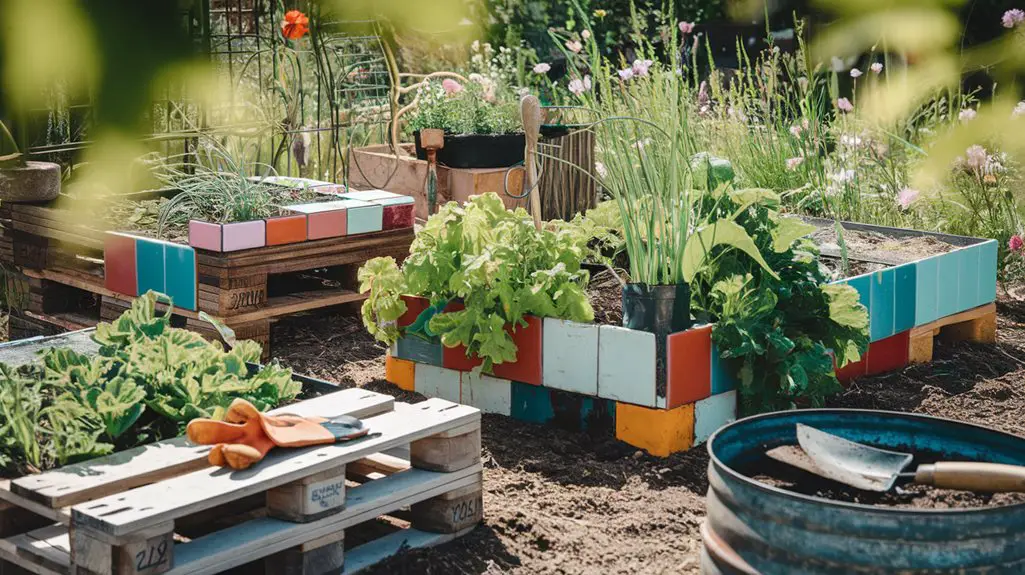Building raised garden beds with recycled materials is a smart way to enhance your garden while being environmentally conscious. You can transform items like old pallets or cinder blocks into functional and appealing garden frames. Not only does this method save money, but it also reduces waste. If you're wondering how to get started and what materials work best, there are plenty of practical tips and ideas to explore.
Benefits of Using Recycled Materials
When you choose to use recycled materials for your raised garden beds, you not only save money but also contribute to a healthier planet.
Utilizing items like reclaimed wood or repurposed bricks reduces waste and minimizes the demand for new resources. This practice fosters sustainability, ensuring that fewer trees are cut down and less energy is consumed in production. Additionally, building with recycled materials often gives your garden a unique character, showcasing your creativity and commitment to the environment.
You'll also benefit from the durability of many recycled options, as they can withstand weather changes better than new materials. Furthermore, using durable materials can enhance the longevity of your garden beds, providing long-term benefits without the need for frequent replacements.
Ultimately, using recycled materials helps you create a thriving garden while making a positive impact on the world around you.
Types of Recycled Materials for Garden Beds
There are several excellent options for recycled materials you can use to build your garden beds.
These materials not only help the environment but also add character to your garden. Here are some great choices:
- Old Pallets: Easily accessible and versatile, they can be disassembled and reconfigured.
- Cinder Blocks: Durable and heavy, they can create a sturdy structure while allowing for drainage.
- Reclaimed Wood: Use weathered lumber from old fences or furniture for a rustic look.
- Bricks or Stones: Salvaged bricks and stones can provide a classic aesthetic and excellent support.
Tools and Supplies Needed

Before you start building your raised garden beds, gather the right tools and supplies to guarantee a smooth process. You'll want to make sure you have everything at hand, making your project efficient and enjoyable. Here's a list of essential items you'll need:
| Tools | Supplies |
|---|---|
| Tape measure | Recycled wood or pallets |
| Saw | Screws or nails |
| Drill | Landscape fabric |
| Level | Soil or compost mix |
Using recycled materials not only saves money but also helps the environment. Additionally, raised garden beds offer numerous benefits such as improved soil drainage and easier access for gardening tasks. By preparing your tools and supplies beforehand, you set the stage for a successful gardening experience. Get ready to create your eco-friendly oasis!
Step-by-Step Guide to Building Raised Garden Beds
Building raised garden beds can be a rewarding project that enhances your gardening experience. Follow these steps to create your own eco-friendly garden beds using recycled materials:
- Choose a location: Select a spot with ample sunlight and good drainage.
- Gather materials: Use reclaimed wood, bricks, or concrete blocks to construct your bed.
- Measure and cut: Decide on the size and shape, then measure and cut your materials accordingly.
- Assemble the frame: Securely attach the sides, ensuring stability and durability.
Once your frame is built, fill it with a mix of quality soil and compost. This sustainable approach not only saves resources but also provides a nurturing environment for your plants. Consider using budget-friendly ideas to make the most of your materials and reduce costs.
Enjoy the satisfaction of growing your own food!
Tips for Maintaining Your Raised Garden Beds

To keep your raised garden beds thriving, regular maintenance is essential.
Start by checking the soil moisture regularly; water when it's dry, but avoid overwatering to prevent root rot.
Mulch around your plants to retain moisture and suppress weeds, which saves time and resources.
Keep an eye out for pests and diseases, and act quickly to remove any affected plants.
Rotate your crops yearly to maintain soil health and prevent nutrient depletion.
Additionally, replenish the soil with organic compost each season to enhance fertility.
Finally, inspect the structure of your raised beds periodically; repair any damage to guarantee they last longer.
Incorporating proper drainage techniques is important to ensure that excess water does not accumulate in your raised beds.
With these simple steps, you'll create a sustainable environment for your plants to flourish.
Creative Design Ideas for Recycled Garden Beds
Maintaining your raised garden beds can lead you to explore innovative ways to enhance your gardening experience, and using recycled materials for garden beds is a fantastic approach. Not only does it benefit the environment, but it also adds character to your garden. Here are some creative design ideas to inspire you:
- Pallet Planters: Stack and secure wooden pallets for a rustic look.
- Old Tires: Paint them in vibrant colors and stack for unique, multi-level beds.
- Cinder Blocks: Use them as borders, allowing for planting in the holes.
- Wine Crates: These make charming and portable raised beds.
Incorporating raised garden beds can also help maximize small spaces effectively. Get creative, and watch your garden flourish while keeping it eco-friendly!
Conclusion
By using recycled materials for your raised garden beds, you're not just cultivating plants but also nurturing the planet. Each salvaged piece tells a story, weaving a tapestry of sustainability in your backyard. With a little creativity and effort, you can transform waste into a vibrant oasis, blooming with life and color. So roll up your sleeves, embrace the beauty of repurposing, and watch your garden thrive as you sow seeds of eco-consciousness.




